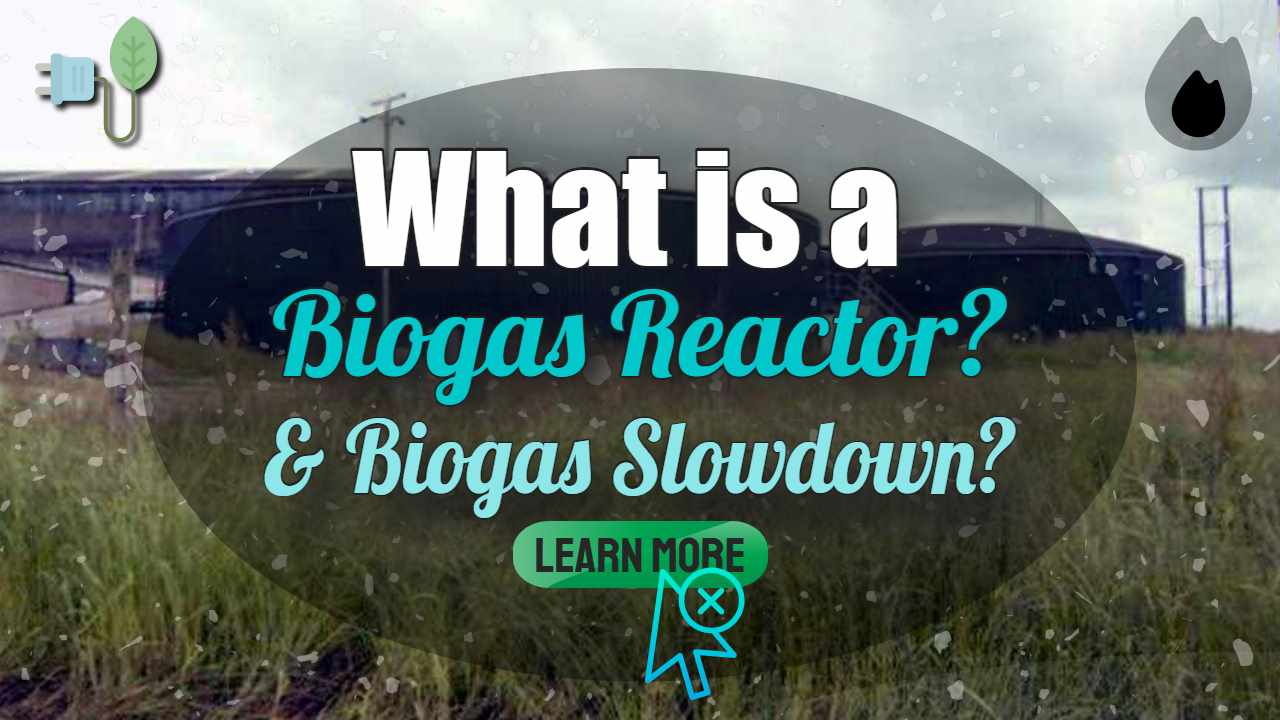For those that ask “What is a biogas reactor” the definition we use is as follows:
Definiton of a Biogas Reactor
These are:
- a digested slurry (digestate) that can be used as a fertiliser, and
- biogas that can be used as an energy source.
Biogas is a mixture of methane, carbon dioxide and other trace gases which can be converted to heat, electricity or light.
The following video explains more about what biogas is:
is…
<< Coming Soon >>
A More Detailed Alternative Definition for “What is a Biogas Reactor”
A biogas reactor is an airtight chamber that facilitates the anaerobic degradation of blackwater, sludge, and/or biodegradable waste (e.g. animal manure, kitchen and garden wastes). It also facilitates the collection of the biogas, a mixture of methane (CH4) and carbon dioxide (CO2) produced in the fermentation processes in the reactor.
The gas forms in the slurry and collects at the top of the chamber, mixing the slurry as it rises.
The pressure exerted by the rising gas can be used to transport the gas to the collection vessel or directly to where it is going to be used. The digestate is rich in organics and nutrients, almost odourless and pathogens are partly inactivated.

Small-scale Biogas Reactors
Small-scale biogas reactors are typically designed to produce biogas at the household or community level in rural areas. In most Small-scale biogas reactors the airtight reactors are buried in the ground and are filled with animal manure from the farm and house.
Kitchen and garden wastes can also be added and toilets can directly be linked to the reactor for co-treatment of excreta.

Large Commercial Scale Biogas Reactors
Although the process in large scale commercial biogas reactors is the same as in the small ones. Large scale commercial biogas reactors vary from the digesters built to service a small farm (i. e. “small” in western terms) up to the digesters built to digest the sludge from a large sewage treatment works. In all cases the definition of the reactor is the same, although the majority of large scale biogas reactors are made from circular steel tanks, which are lagged for the necessary heat retention.
Biogas Slowdown
Biogas Reactors Are Living Organisms: Operator Responses When Biogas Output Drops
Biogas Reactors work well most of the time when the operator uses feedstocks with which the plant operator has experience. But when new feedstocks are introduced, or even occasionally when familiar feedstocks are used, the biogas quality and/ or quantity may drop. It is necessary to take prompt action when the biological process shows signs of imbalance.
In this context, the operator has only a few options available. The operator can:
- reduce the feed rate, or
- cease feeding completely in which case the reactor may stabilise itself,
- dilute the biomass, or
- add fresh or degassed biomass to rectify an imbalance in reactor chemistry where the cause of the slowdown is known.
Adjustment of Biogas Reactor feeding while monitoring the effects of changes on the reactor's biogas production rate and quality are an important tool to correct reactor slowdowns.
But it is difficult to give a precise recipe for doing it successfully.
The Problem of Biogas Output Gradually Falling
Most biogas plants have, to a greater or lesser extent, been subjected to operational disturbances. Sooner or later, even experienced AD plant operators have experienced reactor biogas slowdown.
The digestion (fermentation) process at worst may break down and stop completely. Such a process collapse can have serious financial consequences for the plant. There is no doubt that Biogas Reactor chemistry problems are an issue that focuses the minds of all AD plant owning businessmen.
Downward drifts in biogas output, and even a collapse in the biogas produced in a biogas reactor, are often linked to the types of biomass that the plants are fed with.
Unfortunately, it has been found that a combination of manure and other organic waste of varying strengths and composition, can become a highly odorous, potentially hazardous cocktail if not well managed by knowledgeable AD operators.
Excessive Protein and Fat in the Mixture in the Reactor
If there is a lot of protein and fat in the mixture in the reactor, it can cause high concentrations of ammonium and long-chain fatty acids (LCFA) that may inhibit the process. The best way to avoid such inhibitions is to have a thorough knowledge of the type of biomass that the plant is supplied, both in terms of the chemical composition and how the biomass breaks down in the plant.
In addition, it is important to accurately measure the different types of waste entering a biogas reactor, as well as detailed process monitoring is very important.
Consistent Feed Quality and Quantity s the Key
Unfortunately, it is far from always that the plant operator has the opportunity to feed consistently with the same types of feedstocks to provide the reactor with stable conditions.
The ability of the biogas plant operator to find consistent feedstocks will always be limited by the number and quantities of the availability of feed materials. To keep the reactor microorganisms healthy the operators will therefore often be forced to mix feeds to achieve a consistent blend.
Those biogas plants that are fed from feedstock produced through the operators own business activities (e.g. on-farm manure) have the best chance of ensuring consistent feedstock availability.
To provide a service for the disposal of organic (biomass) wastes for long-term clients makes the need to accept variations in the composition, quantity and delivery frequency of the different types of waste inevitable.
This means that the plants may be forced to supply a certain type of waste to the biogas reactors at a time when it may cause problems with the stability of the biological process.
Finally, complete monitoring of all process parameters is a time-consuming and expensive solution, which means that monitoring at mnay plants is inadequate.
As a consequence of these constraints, various drift disturbances occur at biogas plants.
The question is, therefore:
What can managers do to quickly restore the process when they detect a decline in gas production?
At the Technical University of Denmark, Department of Environment and Resources, they have conducted a series of trials to restore a stalled biogas process in laboratory reactors.
The experiments supported by the Energy Research Program were primarily based on restarting biogas production using a dilution of the biomass with either water, manure or degassed biomass.
The process was inhibited in the first place by adding either ammonium or LCFA to four reactants with cattle gel. The outcome of the different strategies as well as a description of the experiments is discussed below.
Ammonium Inhibition of Biogas Reactors
After inhibition with ammonium, it was found that the most effective method of recovery of the process was to replace half of the reactor content with degassed biomass or fresh cattle gel.
With that strategy, it took about six days to return to the original gas production, while it took 10-11 days if 50% water was added instead, or the daily amount of manure was reduced.
After almost six days, a significant increase in gas production was recorded in the reactor, to which they added 50% fresh cattle gel.
Thus throughout the recovery period, this reactor produced between 42 and 74% more gas than the other reactors, which is associated with the additional amount of organic material that the reactor was supplied in the form of fresh slurry.
However, one should also stick to the evolution of the oxygen level during the restoration, as it gives an indication of how stable the process is. Here it was found that the increase in the acid level was somewhat higher by the addition of fresh manure than by the addition of degassed biomass.
Thus, much evidence suggests that the most effective and safe method of recovery from an ammonium inhibition incident is a combined addition of manure and degassed biomass.
The poorest approach is to do nothing and only add the daily amount of manure or dilute the biomass with water.
The supply of water provides a faster recovery than if it is not intervened, but on the other hand, this strategy leads to relatively low gas production.
The strongest increase in oxygen levels was recorded in the reactor where no intervention was taken, indicating that the process here was more affected than in the other reactors. LCFA Inhibition Inhibition of the biogas process by the administration of LCFA showed substantially the same picture as inhibition with ammonium.
[First uploaded Jul 2017. Updated 11 December 2021.]




I had a biogas slowdown last year. At first we did not know the cause but analysis showed ammonia was too high. We made adjustments and got a new susbstrate source. All sites must take care, but if the slowdown occurs don’t take too hasty a move. Sit tight and analyze to find out cause. We nearly made wrong decision. Must make right decisions. High risk of income loss.
What percentage of biogas reactors go bad a year? I’d like to see some research on that before I invest in such a technology.
Since Prof Charles Banks of the University of Southampton completed research on this problem there is no reason why any digester would ‘go bad’. He published his research in a seminal paper. Just make sure your food waste reactor is given the essential trace compounds he identified in the research, and keep the ammonia concentration within a sensible level. See this link for the details.